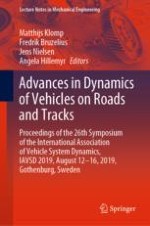2020 | OriginalPaper | Buchkapitel
On-Board Wheel Profile Classification Based on Vehicle Dynamics - From Physical Effects to Machine Learning
verfasst von : Bernd Luber, Felix Sorribes-Palmer, Gabor Müller, Lorenz Pietsch, Klaus Six
Erschienen in: Advances in Dynamics of Vehicles on Roads and Tracks
Aktivieren Sie unsere intelligente Suche, um passende Fachinhalte oder Patente zu finden.
Wählen Sie Textabschnitte aus um mit Künstlicher Intelligenz passenden Patente zu finden. powered by
Markieren Sie Textabschnitte, um KI-gestützt weitere passende Inhalte zu finden. powered by
